I'm having a lot of trouble trying to visualize the waveform of a audio file (.mp3, .wav) using canvas. Actually, pretty clueless on how to achieve this.
I'm using the Web Audio API. I've been playing around with the code on here to achieve my goal: https://developer.mozilla.org/en-US/docs/Web/API/Web_Audio_API/Visualizations_with_Web_Audio_API#Creating_a_waveformoscilloscope. Unfortunately, I'm running into problems. Examples below
How the wave form looks with canvas:
How the waveform of the song should look. (this is from Ableton)

If it matters, the audio buffer size for this song in particular is 8832992.
The Audio Buffer(songAudioBuffer) of this song looks like:
AudioBuffer {
duration: 184.02066666666667,
length: 8832992,
numberOfChannels: 2,
sampleRate: 48000
}
Current program flow: User selects a file from their computer -> User clicks on load -> FileReader reads the audio file and turns it into an ArrayBuffer -> Take ArrayBuffer and create an AudioBuffer
const audioFile = document.querySelector('.audioFile') // Input element where user loads the audio file to
const load = document.querySelector('.load') // button element
load.addEventListener('click', () => {
const fileReader = new FileReader();
fileReader.readAsArrayBuffer(audioFile.files[0]);
fileReader.onload = function(evt){
audioContext = new AudioContext(); // global var
audioBuffer = audioContext.decodeAudioData(fileReader.result); // global var
// Type of AudioBuffer
audioBuffer.then((res) => {
songAudioBuffer = res; // songAudioBuffer is a global var
draw()
})
.catch((err) => {
console.log(err);
})
}
})
function draw(){
const canvas = document.querySelector('.can'); // canvas element
const canvasCtx = canvas.getContext('2d');
canvas.style.width = WIDTH + 'px';
canvas.style.height = HEIGHT + 'px';
canvasCtx.fillStyle = 'rgb(260, 200, 200)';
canvasCtx.fillRect(0, 0, WIDTH, HEIGHT);
canvasCtx.lineWidth = 2;
canvasCtx.strokeStyle = 'rgb(0, 0, 0)';
canvasCtx.beginPath();
const analyser = audioContext.createAnalyser();
analyser.fftSize = 2048;
const bufferLength = songAudioBuffer.getChannelData(0).length;
var dataArray = new Float32Array(songAudioBuffer.getChannelData(0));
analyser.getFloatTimeDomainData(songAudioBuffer.getChannelData(0));
var sliceWidth = WIDTH / bufferLength;
var x = 0;
for(var i = 0; i < bufferLength; i++) {
var v = dataArray[i] * 2;
var y = v + (HEIGHT / 4); // Dividing height by 4 places the waveform in the center of the canvas for some reason
if(i === 0) canvasCtx.moveTo(x, y);
else {
canvasCtx.lineTo(x, y);
}
x += sliceWidth;
}
canvasCtx.lineTo(canvas.width, canvas.height / 2);
canvasCtx.stroke();
}
